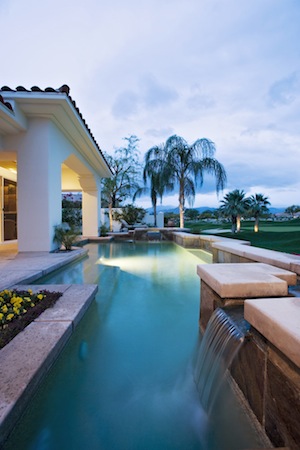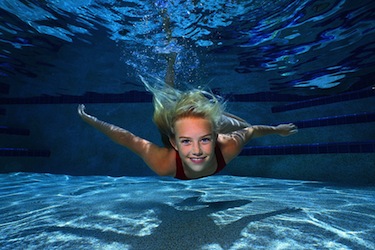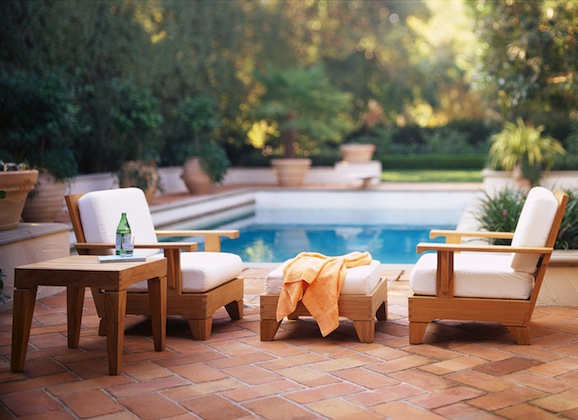Pool Chemotherapy?
Your entire swimming pool is similar to your body’s circulation system. Bodies of water in nature such as lakes, rivers and oceans are open to constant sources of refreshment. The human circulatory system—and a swimming pool circulatory system—is closed. Each recirculate their respective fluids, with fresh liquids added less constantly.
 The one important exception to this analogy is that the human circulatory system manages blood chemistry and the body’s health on its own—appreciate your white blood cells! A swimming pool system needs a human or a system to manage water chemistry and health. Keeping the water in a swimming pool clean is like treating a disease—using antibiotics to cure infection. To rid a pool of unwanted organisms such as algae, the powerful sanitizer chlorine is most often used. Just as drugs have side effects on humans, chlorine has side effects on swimmers, pool equipment, pool structures (such as tile and plastics) and even on the water itself. When humans need antibiotics, their use is short term. But that’s not true with chlorine. Chlorine must be continually present to prevent the growth of algae but the minimum chlorine dosage can be difficult to determine in order to maintain clean water.
The one important exception to this analogy is that the human circulatory system manages blood chemistry and the body’s health on its own—appreciate your white blood cells! A swimming pool system needs a human or a system to manage water chemistry and health. Keeping the water in a swimming pool clean is like treating a disease—using antibiotics to cure infection. To rid a pool of unwanted organisms such as algae, the powerful sanitizer chlorine is most often used. Just as drugs have side effects on humans, chlorine has side effects on swimmers, pool equipment, pool structures (such as tile and plastics) and even on the water itself. When humans need antibiotics, their use is short term. But that’s not true with chlorine. Chlorine must be continually present to prevent the growth of algae but the minimum chlorine dosage can be difficult to determine in order to maintain clean water.
The use of chlorine is a trade-off: you put up with its irritations to keep the water clear, not green. But what if there was a viable alternative to chlorine chemotherapy in your pool? Your main objective is to provide total management of the pool’s water. That means a method to sanitize, manage pH, control hardness and alkalinity, and eliminate the need for stabilizer (cyanuric acid) and other chemicals (softeners, brighteners, algaecides, etc.). Do you really want to add more stuff to the swim?
HOHO ALERT! Time to remember your Home Owner’s Hippocratic Oath: Do no more harm!
Home Owner’s Hippocratic Oath: HOHO
Just as health professionals take an oath to “do no harm” in treating patients, the HOHO is a pledge to do no more harm to the home environment. The idea of “HOHO” may also come to mind when you get advice from certain home improvement experts.
So, before you undertake a home repair or improvement projects ask two questions: How is this going to help? Will this cause any harm?
Consider alternatives to chlorination—many people turn to salt. A saltwater system doesn’t replace chlorine—it makes chlorine. It also destroys pH, adds to alkalinity and leaves unsightly and corrosive salt deposits all over pool surfaces and equipment. Four other systems offer various degrees of relief from pool chemo: ozonators, ultraviolet light, metal based ionization systems and Pureion Technology.
Ozone and ultraviolet light systems are grouped together because they are effective sanitizers in the laboratory or in food processing facilities. These systems are being marketed (in the small print) as supplements to chlorine. Claims of safety vary—most tout a possible chlorine use reduction of between 50 to 90 percent. How can you be sure these systems will work in your pool with such a wide range of possible chlorine reduction? There is no test to determine if they are working as billed. The manufacturers of these systems still recommend keeping a minimum of 0.5-1.0 ppm of chlorine in your pool which, as it happens, is how much you would keep in your pool without an ozone or an ultraviolet light system. What about pH and alkalinity? You still have to use chemicals to manage those.
Using copper or silver– these systems are effective sanitizers on tiny quantities of water. They are more effective in fountains, spas and play pools but have a very difficult time keeping larger pools clean—especially in the hot desert environments of Arizona. Like ozone and ultraviolet light systems, ionization systems claim to reduce chlorine use, and they still don’t manage overall water chemistry.
Finally, the Pureion System uses patent-pending technology to produce a pH balancing, sanitizing ion that completely manages your pool’s water. The Pureion system eliminates the need for supplemental chlorine required by salt, ozone, ultraviolet light and ionization systems. Pureion technology does not require the use of stabilizer (cyanuric acid) and also controls hardness, which helps eliminate mineral deposits on pool surfaces and equipment. These systems are easy to set up with existing swimming pools. If you have a salt-water pool, it must be drained and filled with fresh water before implementing the Pureion System.
With one exception, the companies that market chemical-free swimming pool systems are really selling reduced chlorine and other chemical use in your pool. Pureion’s technology eliminates the use of chlorine, salt, stabilizer and other treatments. Pureion’s approach to freshwater swimming pool management is a radical departure from traditional methods. If you choose a Pureion pool water management system, you’ll unlearn your old method of pool maintenance and adopt a new one. If you only want totally fresh water—no harsh chemicals—in your pool, investigate the Pureion system.
After you practice the HOHO long enough—with your home and your pool—you’ll enjoy the laughter that comes with joy in home ownership, and of swimming in clean, pure water year after year.

















